The Story of Prang Besar Estate
VD NAIR
19 Jalan Kia Peng, 50450 Kuala Lumpur, Malaysia.
Mr V D Nair FISP, the former Manager of Prang Besar Estate was recently contacted by the National Archives about the origin of the name Prang Besar. In this article, Mr Nair describes the results of his collaboration with officers of the Malaysian Archives Department.
The Malaysian Government has recently acquired Prang Besar Estate as the site for the nation's new administrative capital. The estate near Kajang, strategically situated between Kuala Lumpur and the new international airport at Sepang, will be developed into an urban centre housing the offices of the Federal Government. The new 4,000 ha township is scheduled to be completed by 1998 and will be home to almost half a million people. It is planned that the Prime Minister's Department will be the first to move there followed by other government departments except for the International Trade and Industry Ministry and the Public Works Department which will remain in the commercial capital, Kuala Lumpur.
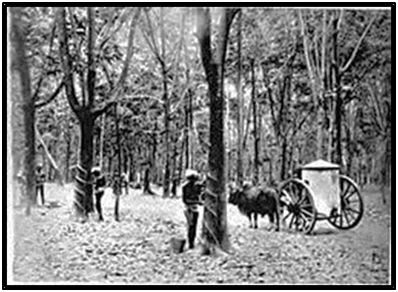
Late in the morning, Indian rubber tappers would collect latex from the cups, pour it into the buckets and then the buckets would be emptied into the large collecting bin on the cart. In the early days the cart was towed by bullocks and the latex in the bin would be taken to the collecting centre to be processed into rubber sheets.
When Prang Besar was acquired by the Government, the National Archives were naturally eager to learn about the history of the estate and find out how Prang Besar obtained its name. In their search for an answer, officers from the Archives Department visited the estate and its surrounding areas. They discovered the oldest living exemployee, one Haji Osman bin Said living in Kajang. However, since he is feeble due to old age and is unable to recollect events, he gave the officers my name. I was interviewed and was able to assist the officers from what I remember as well as from some old personal correspondence garnered from my flies together with the official history of Harrisons and Crosfield which is in my possession.
The early history of Prang Besar Estate is the unique endeavour of three men - Major Henry Gough, Sir Eric Macfadyen and Captain RO Jenkins. The first of these pioneers was Major Edwin Tappen Henry Gough for it was he who selected the land in Ulu Langat District which was to become Prang Besar Estate. Henry Gough was a man of vision who was able to convince his colleagues, all of them ex-serviceman and fellow planters, of the merits of budgrafting and persuaded them to invest their money in his scheme. ·
On 16 August 1921, 900 acres of jungle land was granted to nine officers returned from the Great War as the First World War (1914-1918) was known at the time. During the next three years, this acreage was increased to 2026 acres as other officers who had served in the war took up grants of adjacent land given by the Government. It was the policy of the Government of the day to alienate land to serving British officers to encourage rubber cultivation. The original nine officers formed a private company to develop the block of virgin jungle selected by Gough.
They named the company Prang Besar Estate Ltd. in commemoration of the Great War, "the war to end all wars", in which they had fought. The seal or chop adopted by Prang Besar Estate showed a young rubber tree rising out of a shell explosion and was designed by one of the nine, Lt. Commander JC Amcotts, DSC, RN. Another pioneer was Commander GHA Willis, CB, RN, who had a field Ladang Willis named after him. ETH Gough remained a Director of Prang Besar Estate Ltd until his death in 1952.
From the start, the main efforts of Prang Besar Estate were:
• to get the whole estate budgrafted with the best material possible
• to conserve the soil
• to lay the foundations for producing high yielding trees with good secondary qualities and
• to produce seed which would breed true to type.
In a mere six years, Gough who had no previous scientific training became the leading expert in rubber selection and budgrafting. In 1926, the former soldier published the first edition of Gough's Practical Budgrafting and Seed Selection of Hevea brasiliensis. Gough acknowledged the help and encouragement in the earliest days of Prang Besar of RCM Kindersley of the two Kindersley brothers who opened up Kajang Estate, later known as Inch-Kenneth Kajang. Ronald CM and Douglas CP Kindersley were among the first to experiment with soil conservation methods. The parent tree of clone PB 86 is well known as a parent of many modern clones and extensively planted in its day came from Kajang Estate. This tree, until a few years ago was especially protected by a fence constructed around it and could be seen on the left-hand side of the Kajang-Seremban road.
As far back as 1924, Gough established two seed gardens, each protected against pollinating agents from outside by some 25 chains of jungle.
His diary recorded his objective: “To discover three types of improved breeding value”.
These gardens situated in the Bangi jungle had to be abandoned because of attack by monkeys and other predators. Later seed gardens were successfully established within coconut plantations located on the Bagan Datoh peninsula in Lower Perak. Seedlings from the Prang Besar Isolation Garden (PBIG) and Prang Besar Gough Garden (PBIG-GG) have been widely planted in Malaysia and overseas.
The 1952 Annual Report of Prang Besar Estate Ltd refers to: "the death last April of Major ETH Gough who was the initiator of Prang Besar and remained up to practically the end of his life closely identified with its fortunes.”
It was in Java that budgrafting, as a means for improving the strains of cultivated rubber, was first worked out at a time when many of the more enterprising of British planters were serving in the First War. Returning to the East after the war, Gough was impressed by the promise of higher yields held by this new technique, and embarked upon a crusade for budgrafting in Malaya. He became involved in a lively controversy on the subject and made up his mind to justify the faith that was in him by planting up a budgrafted estate. With a few friends he took up the land which became Prang Besar Estate. After careful selection from among the hundreds of thousands of trees growing on estates in the neighbourhood of Kajang, Selangor, he purchased budwood from what he considered the best available budparents. By 1926, he had planted 1000 acres and had established over 600 clones. To carry the project forward this company was formed.
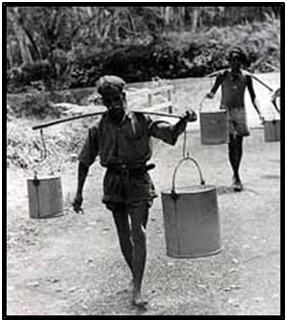
Tappers carrying the latex in large metal buckets to the collecting bin.
The second of the pioneers was Sir Eric Macfadyen. Whereas Henry Gough was an ideas man; Eric Macfadyen was a corporate man. After studies at Oxford University, Macfadyen in 1902 joined the Malayan Civil Service and spent three years in Taiping, Kuala Selangor and Kuala Lumpur before deciding that the newly emerging rubber industry was the career for him. He wrote in the Straits Times of 6 October, 1936 that in 1903 "I first saw rubber trees from the window of the train on my way from Klang to Kuala Lumpur. ‘There - that is the new kind of rubber the planters are taking up' said my companion, pointing out a small three year-old clearing on the right of the line, as we puffed up-hill past Sungei Renggam. He added that he believed it was known as Para rubber. With rambong the indigenous Ficus, he no doubt assumed we should all be familiar."
Macfadyen resigned from government service in 1906 and became an assistant planter on Jebong Estate (where the jebong tapping knife was invented) near Taiping. Of his time on Jebong, Macfadyen says: "I could not have had better luck either in my manager, my fellow assistant, or the estate: in particular the art of tapping was brought up to a standard on Jebong, in quite early days, which was not attained on the generality of rubber estates for many years." The first piece of land he bought in the Banting district became his own estate which he named Lunderston, after his father's home in Scotland. The opportunities created by the rubber boom of 1909 and 1910 inspired Macfadyen, and his energies led him into other rubber enterprises.
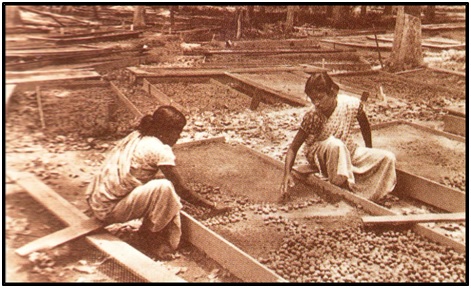
Indian estate women sorting rubber seeds. They look for seeds that are heavy, shiny and fresh, without, scars or cracks, before being sprouted in sand, charcoal dust, sawdust or husk in the nursery.
In 1913, he joined two friends who had started an independent firm of Visiting Agents to provide advisory services to estates. Sir Eric told me jokingly once that his advice was much sought after "because he charged the most." Macfadyen's brilliance and expertise in rubber had come to the attention of Harrisons and Crosfield (H&C) who invited him to join them. After military service in the Great War, Macfadyen joined the company and became a leading force in the rubber plantation industry for the next 40 years.
How Eric Macfadyen came to acquire Prang Besar Estate is interesting. He said to me that in 1925 he disembarked at Port 'Swettenham (now Port Klang) when he trod on one of the partners of Prang Besar Estate who during the ensuing conversation related that he was awaiting the outcome of negotiations for the sale of Prang Besar to a London group. Without further thought Sir Eric made an appointment to visit Prang Besar where he was impressed by the aims and objectives of Gough. Macfadyen decided the estate would be a valuable acquisition for the H&C group of plantation companies. He bought Prang Besar from Gough and his partners on 1 December 1925 and Gough duly joined H&C.
In conceiving his scheme for the purchase of Prang Besar, Macfadyen saw the contribution that research in Malaya and Sumatra could make to the estates for which H&C were Agents. To this end he sent a letter to all the H&C plantation companies advocating that each rubber company in the Agency should subscribe to Prang Besar. His invitation letter stated that although a considerable amount of research had been done by individual estates, such work could not be carried out to the fullest advantage on estates which had to operate on commercial lines. It would seem that Macfadyen must have realized the converse of this statement, namely that Prang Besar as a research station would have to put profit in second place.
If Gough was an ideas man and Macfadyen a corporate man then RO Jenkins was an organizer. Jenkins, the third of the pioneers, was a Welshman who after distinguished service in the Great War, went out as a planter to Malaya. Jenkins succeeded Major Gough as Manager of Prang Besar in 1926. Subsequently he became a Visiting Agent to the H&C Agency House in Kuala Lumpur before becoming Chairman of Prang Besar Estate company in succession to Sir Eric Macfadyen.
In the 1954 Annual Report the Chairman, Sir Eric Macfadyen stated: "Major Henry Gough who started Prang Besar in 1920 was at that time an outstanding personality of the Malayan Planting Community. Almost by sheer force of character alone he imposed upon his contemporaries the policy of improving their rubber by scientific selection. In those days there was no Rubber Research Institute (RRI) - indeed the example of Prang Besar was one of the factors which contributed to the demand by the Planting Community that it should have its own research industry. It fell to my colleague Mr RO Jenkins, who as a young man succeeded Gough as Manager, to consolidate Gough's work and to establish the reputation of Prang Besar planting material throughout Malaya and far beyond, and Mr Jenkins has left his stamp permanently upon our undertaking. Mr RO Jenkins continued to give the Company invaluable service as Manager and later as Visiting Agent throughout the years up to the time of the Japanese invasion. After RO Jenkins' death in 1975 at the age of84 I wrote in the obituary published in The Planter 11:
“when I began my career on the estate, the name of RO Jenkins was redolent with the heavy scent of being a clever VA in the planting circle."
RO Jenkins was succeeded as Estate Manager by Mr Martin Wright in 1930. Wright was imprisoned during the Japanese War. After the reoccupation, Wright returned and rehabilitated the estate after 45 months of neglect. Martin Wright retired after 25 years of service and was succeeded by Mr Gordon Travers who previously had been a Visiting Agent. He did not remain long as he was due for retirement.
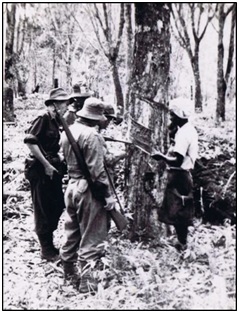
I joined Prang Besar in 1941 as an Asiatic staff - in those days all staff other than Europeans were classified as Asiatics. At this time the estate was considered malarial and labour short being remotely situated, which is 10 miles from Kajang. Everyone on the estate was advised to take prophylactic treatment for malaria which surprisingly almost disappeared after the reoccupation. The Japanese occupation caused much disruption on the estate and the country was also in turmoil. British soldier and local constables talking to tappers to elicit information and to provide protection against communist insurgents.
The Emergency broke out with the murders of three planters on Elphil and Sungai Siput Estates in Perak on 16 June 1948. The communist insurgency caused severe strain for everyone working on Prang Besar as it did for staff on estates the length and breadth of the country. The special constabulary squad headed by Police Lieutenants and the Army frequently patrolled the estate and its surrounding areas. Senior staff members were provided with armed escorts. There were numerous reports of bandits lurking in the jungle bordering the estate.
Three bandits belonging to the notorious Liew Kon Kim gang were killed in the 1950 new clearing on the edge of the jungle. Two tapping contractors returning from work were ambushed and shot dead by bandits in front of their workers. Around the same time a car transporting school children including my son travelling from Kajang was shot at but there were no casualties, except for loss of tyres. The estate had a large resident labour force and despite the difficulties the workers on the estate worked contentedly.
On the retirement of Mr G Travers, I was chosen to succeed him as Manager to the disappointment of some. I remember writing in the Handing-Over Report to the Agents that the transfer of the estate to me by Mr Travers "was not with his blessings but with obsession." In those days anything better could hardly be expected and my promotion to a senior managerial position was the beginning of a new chapter in the history of Harrisons and Crosfield Ltd.
Whilst I was the Manager, two of Gough's erstwhile employees, Yee Yam and Osman, retired. They were mainly involved in hand pollination and selection work, and were regarded as specialists in this field. Haji Osman bin Said who is still living in Kajang was born in 1903. In 1922 he joined Prang Besar Estate as a labourer. Because of his hard work and his skills as a 'born agriculturalist', Haji Osman was promoted as a Special Side Conductor. Haji Osman retired in 1960, after 33 years of service with a gratuity and pension. The pension (revised to RM 150 per month) is still being paid today in recognition of Osman's contributions.
I retired from Prang Besar in 1961 and I look back with pride at Prang Besar's contribution to the science of rubber planting. As RO Jenkins in his 1955 Annual Report on the estate operations stated:
"The best of RRI 600 series new clones are exceptionally promising; no less so than the best of the Prang Besar new clones. It is a stimulating thought that of the probable best half dozen or so RRI clones, all but one are from bud parents derived from combinations with a Prang Besar clone. Thus, as Sir Eric Macfadyen had hoped some 30 years ago Prang Besar has brought advantage not only to its shareholders but also to rubber plantations generally in Malaya and elsewhere."
The Government has announced that the name of the new capital city will be Putera Jaya. I hope that the name of Prang Besar with its unique history and great contributions to the rubber growing industry would not be forgotten. Rubber after all was one of the twin pillars of the economy on which the present day prosperity of Malaysia has been built. It would not be inappropriate for the authorities to consider, for example either retaining the name Prang Besar for a section of the new township, or perhaps a road be called Jalan PB 86.
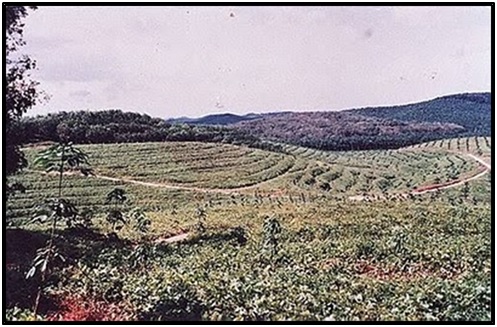
A more recent picture of Prang Besar estate taken in the 60s.
REFERENCES
ARKIB NEGARA MALAYSIA (1994) Pengkisahan
Sejarah Prang.Besar.
GOUGH, E T H (1944) Letter to Harrisons and
Crosfield Ltd, May 1944.
MACFADYEN, E (1936) Recollections and personalities of early planting. In A Miscellany of 75 Years : Incorporated Society of Planters
1919-1994 (eds J Bush and K K Khoo). The Incorporated Society of Planters, Kuala Lumpur. NICKALLS, G (ED.)(1990) Great Enterprise :A History of Harrisons & Crosfield. London :
Harrisons and Crosfield.
THE PLANTER (1927) Editorial: A pioneer of budgrafting. In A Miscellany of 75 Years: Incorporated Society of Planters 1919-1994.The Incorporated Society of Planters: Kuala Lumpur. PRANG BESAR ESTATE LTD. (1952, 1954, 1955)
Annual Reports.
THE STAR (1994a) Recalling history of rubber estate.
26 November, 1994: Kuala Lumpur.
THE STAR (1994b) Putrajaya plan for cabinet soon.
28 November, 1994: Kuala Lumpur.
A Review of Prang Besar's Quest for
Improved Hevea Planting Material*
M. NAND
"Lovedale"- Jail Road, Talap, Cannanore 670 002, Kerala, South India.
Preface
Here is a review of Prang Besar's search for improved planting material which will elucidate the key role played by Major Gough and Dr Chittende». Written 40 years ago and sent to the Prang Besar Board by Harrisons and Crosfield, I received a personal letter from R O Jenkins the then Chairman thus:
"K.L. has forwarded to us a copy of your PB story from Gough to the present day. It is a most creditable piece of work on your part, factual and well-written. It will be read by all my colleagues on the Board and by Mr Mcinnes, our secretary with pleasure and interest.
Full marks.
With best wishes"
I do not know whether this review written 40 years ago has any relevance now. But I am sending it as Prang Besar will soon be extinct, as it has come into prominence as the future administrative capital of the nation.
There may be people even among the present day planting community who do not realise the value of Prang Besar's contribution to the plan.ting industry to which Major Gough and Dr Chittenden have put an indelible mark.
THE PIONEER
As centenarian Ridley is the accredited pioneer of the rubber industry in the East, so is Gough the pioneer of budgrafting rubber in Malaya. It was around 1921 that Gough opened up Prang Besar Estate, and a year later, made his first attempt to budgraft rubber on a commercial scale. Rubber planters viewed this undertaking, a new departure from the conventional practice of planting seed, with pessimism. Gough in carrying out his programme got very little encouragement, even though he was assisted by the Department of Agriculture and received valuable guidance from Dr Heusser of the AVROS Research Station, in Java. He was the least perturbed by what others thought about his idea. By his courage and determination, he persuaded and convinced his colleagues, a group of ex-service men and fellow planters, of the advantages of budgrafting and managed to win them over risking their money, as it was then feared that the whole project would be a failure.
EARLY HISTORY
Gough foresaw the advantages of budgrafting rubber, and in 1921 he scanned over a million mature rubber trees growing in the district of Kajang, to select the best trees for use as bud-parents. Little was known about the "genetics" of rubber and his selection was based on yield and vegetative characters.
From these million trees, he selected 618 and made them into clones and employed them in planting up Prang Besar (in 1921). These clones were scattered on over 1000 acres to subject them to varying soil conditions and environment.
When these clones reached maturity, they were scrutinized for desirable qualities, from the practical planter's point of view, such as a straight round stem, smooth bark, well developed and poised crown etc. and, above all, yield. After selection from visual observations on the above lines, only about 100 clones were considered suitable for testing for yield and they were test-tapped. As a result of this test-tapping and the additional experience and knowledge gained thereby, the clones was later reduced to a mere 30 in number, which, after prolonged test, were further reduced to 16.
Not being quite sure of how the buddings would perform, and as an insurance against their possible failure, Gough planned an initial stand of 200 trees per acre, interplanting selected seedlings and buddings in equal proportions. The area came into tapping in 1927/28 and in 1934 the overall yield was 530 lb per acre per annum. This yield, even at the 1934 standard, could not be called surprisingly high but could be regarded as quite good.
HARRISONS & CROSFIELD COMES IN
Gough's embryonic selection work gave Harrisons & Crosfield the insight into the great possibilities, in developing the estate on other lines, than that of a commercial estate, producing and selling rubber and when in 1926, the original Prang Besar Estate was bought by Sir Eric Macfadyen, for Harrisons & Crosfield, he directed, that investigation and production of improved planting material, should be another vital object of the company. With the appointment of Dr R J Chittenden as geneticist, in 1927, the idea took shape.
BREEDING WORK
Dr Chittenden started his breeding work in 1927, with the best of Gough's original selected valuable material. He used it in a series of dia:llel crosses, in his hand pollination programme. Legitimate seedling families were thus raised and planted out commercially, for observation and testing. He purposely planted his hand-pollination plots at a reduced stand, as he did not contemplate any thinning out, except by natural means; nor did he make any selection in the nursery. Every hand-pollinated seedling was used.
HAND-POLLINATION PLOTS
The first hand-pollination plot was planted in 1928 and thereafter, every year, small plots were added. The size of these plots depended on how many families were produced and the number of seedlings that could be raised. Prang Besar now possesses nearly 172 acres, planted with seedlings raised by hand pollination, in 22 plots, situated in different parts of the estate. Of these, 79 acres are prewar plantings and the remaining postwar ones. About 8 acres of the latter are mature rubber which is under test and the balance of 85 acres contains rubber of varying ages, the oldest being about five years and the youngest only a few months.
The hand-pollinated plots (known as P-Plots on Prang Besar) P1 to P5, planted 1925/28, contained 39 legitimate families and the results of the first 29 months of experimental tapping of the families, on the S/2, d/2, 100 per cent system, is summarized and produced in the Planters Bulletin, No 11, March 1954.
The mean yield in pounds per acre is shown as 1920.6 which could be considered very satisfactory. During 1934/37, a further five P-Plots were established- P7, P8, P9A, P9B and P10. P7 was planted in 1934 and in its seventh year from planting, yielded an average of 70 lb per month. The other P-Plots were too young and the Japanese war prevented the areas being tested according to Prang Besar's schedule and actual test-tapping was started only some time after the re-occupation.
Dr Chittenden continued his breeding work after the re-occupation, mainly from Gough's original selection, which was augmented by his own selection and a few clones from neighbouring rubber growing countries, until his death on 6 December 1949. Where he had left, his successor Keiding continued the breeding and selection work.
PROVING OF CLONES
As a result of breeding and selection Dr Chittenden evolved a large number of newer clones, the better ones amounting to about 60. These clones were tested in two stages. In the early stages of breeding and selection, all hand-pollinations were made into clones, which were interplanted with one or more proved clones as control. This method, though advantageous, called for large acreages and in later years only the best hand-pollinations were selected for vegetative propagation. But, of late, this method has been reversed and the original method of making all seedlings of the different families into clones when big enough to be used as budparents, is in vogue. Thus the hand pollinated seedlings and the clones raised from them could be tested simultaneously, which means a saving of time in the proving of clones.
PRELIMINARY PROOF
The first stage of testing is preliminary proof. The selected hand-pollinated seedlings, after at least two years of test-tapping, and if found satisfactory, in respect of both yield and vegetative characters, are made into clone$ and planted out in the field under normal commercial conditions, each clone occupying 15/20 trees. The control, in most cases, is PB 86, a very reliable all round clone. The aim was to get at least 10 trees at the tapping stage, for testing. These preliminary proof areas received no favourable treatment and they are treated identically with other commercial areas on the estate.
The performance of these preliminary proof clones is carefully observed in regard to their growth, nature of the bark and other vegetative characters and most important of all, the yield. High yield and the most desirable characters are the important factors in selection. An awkward tree, however high the yield might be does not merit selection.
FURTHER PROOF
The second stage is further proof. After at least two years of test-tapping in the preliminary proof areas, clones which have yielded 25 per cent and more than the control and which have satisfactory vegetative characters, are picked out for further proof.
The further proof areas are laid out statistically in randomized and replicated blocks, each clone occupying roughly 1acre. The control is nearly always PB 86, a highly reputed clone in the East and especially in a favourable habitat. No doubt, clones behave differently, under different environmental conditions.
The object of laying out the further proof areas statistically, is to ensure that the conclusions drawn are reliable and accurate. In any experiment with agricultural crops, our observations and conclusions might be influenced by several factors, some of which, like soil variation, are recognizable, while others are beyond our control. The latter would cause one to draw wrong conclusions. Randomization and replication: allow the researcher to evaluate the degree of error in his observations and arrive at more reliable and accurate conclusions.
EXPERIMENTAL RESULTS
The Prang Besar, June 1941 circular, gives a list of 60 new clones tested and the results.
In the April 1948 circular are produced tapping results and a vegetative description of70 preliminary proof clones and 20 further proof clones under test: Of these 70, Dr Chittenden recommended only a dozen for small-scale experimental planting.
By 1951, the further proof clones under test, dwindled to a mere 18, the less promising ones having been discarded for low yield and/or less desirable vegetative characters. In the same year, the preliminary proof clones under test fell to 32 from 70. It would be realised that some of the clones are undergoing both preliminary proof and further proof tests. After continued selection of the better clones and rejection of the less desirables, Prang Besar, in their July 1955 circular, recommend only 11 clones, of which three are recommended for planting "in blocks of up to 25 acres"; the remaining eight in "blocks of 15 acres".
How rigorous is the selection and how careful their recommendation, can be judged from the above.
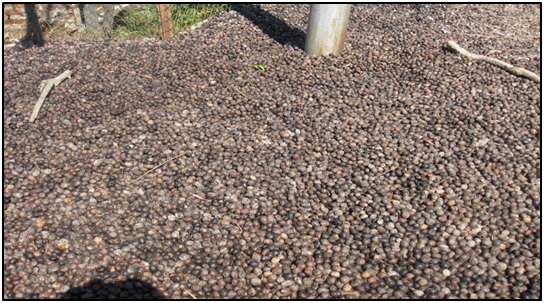
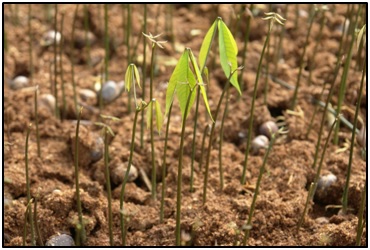
A Rubber Nursery - Seedlings sprouting from rubber seeds
SEED GARDENS
Prang Besar's seed gardens C, D and E contain the best clones raised from the 9 families in P 1 to P 5. These gardens were initially planted, as polyclone plots of a speculative nature, the constituent clones in them, being those raised from Gough's original selection. These have produced valuable seedling progeny and buyers of C, D and E seed have been encouraged in its further use in sub sequent plantings from the very satisfactory results obtained. "
Seed from isolation gardens C, D and E was statistically tested in a 6 x 6 Latin Square Experiment consisting of four-and-a-half acres randomized blocks against:
• Budded stumps in equal proportions of PB 186, 183 and 86
• Open pollinated seed of good quality
• Open pollinated seed of Prang Besar origin
• Plot C seed (isolation garden)
• Plot D seed (isolation garden)
• Plot E seed (isolation garden)
The tapping results were published in Prang Besar's June 1941 circular. The yield of C, D and E is bulked and shown as "yield of isolation garden .seed plots". In all cases, in the experiment, the isolation garden seed plots have yielded more than any other type tested.
Encouraged by these results, Prang Besar recommended this material for large scale planting and the results show that the company has been justified in doing so and they can rightly be proud of their material. They did not stop here. The search for still better planting material continued and a further two seed gardens F and G were opened up. The constituent clones in these gardens, are an improvement from those used in C, D and E and from theoretical considerations the progeny from these gardens, should be considered as an advancement on the previous gardens C, D and E.
The surest test to evaluate any planting material, is to plant out fairly large areas under commercial conditions, in different soil types and environmental conditions and see the results.
Sale of F and G seed commenced only after there-occupation and such areas as have been planted post-war, have reached the bearing stage only fairly recently and there fore tapping results are few. But the few results available (see Prang Besar, July 1955 circular) are encouraging and indicate that F and G seed are an improvement on C, D and E.
In their never ending and untiring quest for better and still better planting material, Prang Besar opened up a still newer seed garden, guided by their past knowledge and experience. This garden is named "Gough Garden" to commemorate the pioneer of budgrafting (in Malaya), who was the first to initiate selection work on Prang Besar. The seed from this garden is now marketed as Gough Garden seed.
Sale of Gough Garden seed commenced only a year ago and it is too early to pass any judgement about its value, until areas planted with his material come into tapping, which will not in any case be earlier than 1961. Nevertheless, the experience of more than 25 years of breeding and selection has gone into the composition and layout of this garden and it can be considered that Gough Garden progeny may be an improvement, on all seed types, so far marketed by Prang Besar.
All Prang Besar seed gardens aforesaid, are situated in Perak and each plot is adequately protected from each other, by large areas of coconuts. Apart from the seed gardens, there is no other rubber nearby, the extensive areas surrounding them being coconut estates.
PLANTING RECOMMENDATIONS
Under "Planting Recommendations, 1955/56", the Rubber Research Institute of Malaya (RRI) have classified, among others, PBIG seeds from isolation gardens C, D and E as class / and recommended its use to the extent of 80 per cent of any replanting or new clearing. Obviously the RRI have to be extremely cautious in their recommendation, and they, in view of the fact that very little is known about the performance of F and G seed, under commercial and varied conditions, have graded this as Class II. Their planting recommendation of this material is "in the aggregate of 20 per cent of any new or replanting".
THE AIM
Broadly speaking, the aim of the plant breeder is the improvement of the material he is dealing with. The methods he uses, depend on the type of material on which he is working. One of the methods, often used.in the improvement of agricultural crops is in breeding and crossing of the inbred lines.
In Hevea, this method is, from a commercial point of view, thought less desirable. When inbred, there is the risk of Hevea losing vigour and yield. A high degree of hyterozygosis is also thought probable. Inbreeding and improving Hevea may therefore require a large number - but how large has not been determined- of generations before anything approaching a pure line could be obtained. Such an expensive and lengthy process should be left to the research worker.
The aim of an ordinary estate trying to produce improved planting material, in the hope of fair and quick returns for the money invested, will mainly be concentrated in producing high yielding families by crossing proved and promising clones. It is with this objective, that Prang Besar started their search, by interbreeding and selection and they have been encouraged by the results so far obtained.
FUTURE PROSPECTS
It is a well-known and accepted fact, that the planting industry in Malaya developed into its present state from about a few thousand seedlings introduced in the East, some 75 years ago. So much interbreeding would have, therefore, taken place by now 'that it may be assumed the material available iri the East is already homozygous to some extent and further breeding and selection with the existing material, therefore, may not produce phenomenal results.
But, with the introduction of new material from Brazil (the RRI is reported to have some) and the wide range of material already developed in this country and other neighbouring rubber growing countries, the geneticist's scope is indeed great and it may be possible, in years to come, that there can be planting material, capable of producing more than a ton of rubber per acre per annum. By carrying out hand-pollinations and testing the families thus produced, the plant breeder is able to evaluate the families and judge the value of clones as parents. With the discovery of newer clones, valuable as seed parents, isolation gardens could be established to produce improved seedling progeny. As new and better clones supersede improved seedling material, selections from the latter and breeding from them, will give rise to still better clones and the process continues and the quest for more and more improved planting material is never ending.
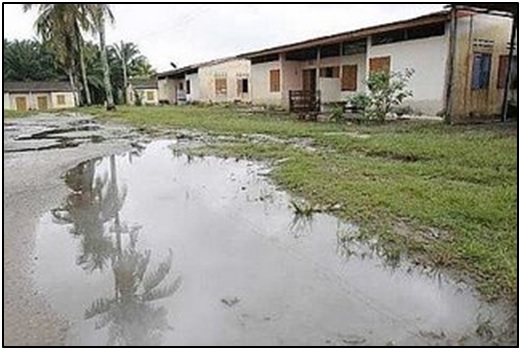
Workers’ quarters on Prang Besar estate

Pondering their future
When Prang Besar estate was closed many of the workers lost their homes and their livelihoods too. Some took up the offer of alternative lodging in Dengkil and Nilai but many refused to resettle in a new place and have continued living in the vicinity of the then Prang Besar estate. Some have found jobs as rubber tappers while others continue working on neighbouring palm oil estates.
